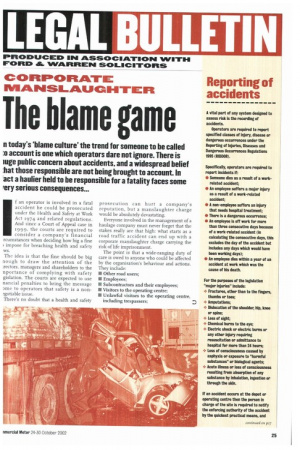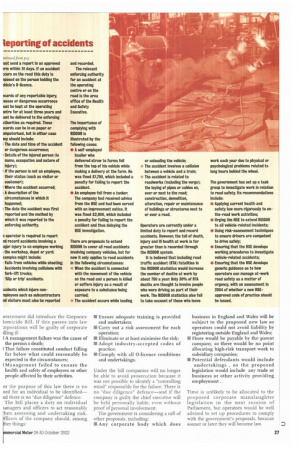The blame game
Page 25

Page 26

Page 27

Page 28

If you've noticed an error in this article please click here to report it so we can fix it.
n today's 'blame culture' the trend for someone to be called :o account is one which operators dare not ignore. There is iuge public concern about accidents, and a widespread belief .hat those responsible are not being brought to account. In act a haulier held to be responsible for a fatality faces some rery serious consequences...
1 f an operator is involved in a fatal
accident he could be prosecuted under the Health and Safety at Work Act 1974 and related regulations. And since a Court of Appeal case in 1999, the courts are required to consider a company's financial rcumstances when deciding how big a fine impose for breaching health and safety ws.
The idea is that the fine should be big nough to draw the attention of the rectors, managers and shareholders to the nportance of complying with safety gislation. The courts are expected to use nancial penalties to bring the message 3me to operators that safety is a nonTotiable issue.
There's no doubt that a health and safety prosecution can hurt a company's reputation, but a manslaughter charge would be absolutely devastating.
Everyone involved in the management of a haulage company must never forget that the stakes really are that high: what starts as a road traffic accident can end up with a corporate manslaughter charge carrying the risk of life imprisonment.
The point is that a wide-ranging duty of care is owed to anyone who could be affected by the organisation's behaviour and actions. They include:
• Other road users;
• Employees;
• Subcontractors and their employees;
• Visitors to the operating centre; MI Unlawful visitors to the operating centre, including trespassers; P • People working at the pick-up and delivery points.
To prove a case of manslaughter the prosecution has to prove that: III There has been a breach of duty of care (negligence);
• This breach has caused death and was negligent (ie was gross): • The negligence was the significant cause of the death; • The negligence was so gross that any jury must regard it as criminal.
The courts have found that the following cases showed such disregard for human life that the conduct was considered grossly negligent:
MI Failing to regulate a driver s hours and failing to ensure that he did not drive while he was exhausted (the Bowles case); • Failing to provide employees who steam cleaned toxic chemicals from the inside of a tanker with protective clothing, first aid and facilities to treat exposure to the toxic chemicals (Jackson Transport (Osset)).
Bereaved relatives recently petitioned the High Court to review the Crown Prosecution Service's refusal to prosecute an employer for corporate manslaughter. In dismissing the application the court clarified the CPS's duty when considering whether to bring a prosecution. It must consider the interests of the victims, but it is primarily required to make an objective evaluation of the evidence in the case and the prospects of a successful prosecution. In other words the decision should not be influenced by emotive pressures.
Following the Southall rail disaster First Western was prosecuted for manslaughter. The trial judge directed that the company be found not guilty because the prosecution must prove a "guilty mind". A non-human defendant could only be convicted via the guilt of a human with whom it could be identified—but in this case no human was charged because no director who controlled the company could be identified as negligent.
The case went to the Court of Appeal for clarification of the law. Its opinion was that a defendant could be guilty of "manslaughter by gross negligence", even in the absence of evidence about the defendant's state of mind.
However, a company could only be convicted of manslaughter by gross negligence if a "directing or controlling mind" could be identified (ie a director).
If the prosecution can identify a "controlling mind", then a fatality could result in both the company and the director being prosecuted fr manslaughter. Small organisations ai most vulnerable to such a prosecutio because one or two individuals can usual be proved to be responsible for the methc of working and having a direct IcnowlecIE of that work. it is much more difficult 1 prove this in large companies.
However, in May 2000 the governmet announced proposals to reform the law o involuntary manslaughter. The proposa are for a person to be guilty of reckleE killing if he was knew his conduct migl cause death or serious injury and it woo] be unreasonable for him to take that ris in the circumstances.
With regard to the proposed charge c "killing by gross carelessness", a perso would be guilty if: • The risk of death or serious injury caul be obvious to a reasonable person in h position; • He would be capable of appreciatin that risk; • His conduct would fall below what coul reasonably be expected in th circumstances, or he intended by hi conduct to cause injury, or was awai that it might cause injury an unreasonably took the risk anyway.
To date no legislation has been drafted o either of these proposals, but in 200T th
overnment did introduce the Corporate lomicide Bill. If this passes into law arporations will be guilty of corporate ailing if:
I A management failure was the cause of the person s death; I That failure constituted conduct falling far below what could reasonably be expected in the circumstances;
!Management failed to ensure the health and safety of employees or other people affected by their activities.
or the purpose of this law there is no eed for an individual to be identified— rid there is no "due diligence" defence. The bill places a duty on individual 'tanagers and officers to act reasonably i.i
hen assessing and undertaking risk. fficers of the company should, among er things: • Ensure adequate training is provided and undertaken;
• Carry out a risk assessment for each operation;
• Eliminate or at least minimise the risk; • Adopt industry-accepted codes of practice; • Comply with all 0.ficence conditions and undertakings.
Under the bill companies will no longer be able to avoid prosecution because it was not possible to identify a "controlling mind" responsible for the failure. There is no "due diligence" defence—and if the company is guilty the chief executive will be held personally liable, even without proof of personal involvement.
The government is considering a raft of other proposals, including: • Any corporate body which does business in England and Wales will be subject to the proposed new law so operators could not avoid liability by registering outside England and Wales; • Fines would be payable by the parent company, so there would be no point allocating high-risk transport work to subsidiary companies;
• Potential defendants would include undertakings , so the proposed legislation would include any trade or business or other activity providing employment.
Time is unlikely to be allocated to the proposed corporate manslaughter legislation in the next session of Parliament, but operators would be well advised to set up procedures to comply with the government's proposals, because sooner or later they will become law.
To reduce risks operators must carry out an assessment of the risk involved in each particular activity in which their employees and others are involved.
Operators have a duty to assess the risks to health and safety of anyone who may be affected by their activities, including drivers. warehouse office and workshop staff, subcontractors and members of the public.
All operators should undertake a risk assessment-and if an operator has five or more employees he is required to record the significant findings of the assessment.
The assessment should be reviewed and revised regularly—and at any time that the operator suspects that it is no longer valid or particularly if there has been a significant change in circumstances. Where possible the risk should be reduced or eliminated. This could include: • Eliminating unnecessary vehicle movements; • Avoiding driving in adverse conditions; • Reducing the distances travelled: • Planning journeys better and using safer routes: • Ensuring vehicles are appropriately equipped.
By December of this year operators must also have taken measures to ensure that mobile work equipment is safe for use. This includes ensuring that all vehicles are fitted with seat-belts.
Once an assessment has taken place operators can take steps to avoid or eliminate risks. such as taking measures to prevent falls or falling objects.
The need to climb on top of vehicles should be avoided as far as possible. If unavoidable. measures should be taken to prevent falls.
In particular, when assessing the risk to drivers from top loading tankers, operators should try to eliminate the need for the driver to climb on top of the vehicle. If it is unavoidable, fencing or other equipment to prevent falls should be fitted.
Loading and unloading are particular risk areas. Tippers should be loaded and unloaded in a level area from which non
essential personnel are excluded. The manual sheeting of tippers should be reduced and wherever possible replaced by the use of mechanised sheets controlled from ground level.
Any assessment of the risk of climbing on top of a vehicle should include an assessment of what that risk would be in adverse weather conditions. If necessary instructions should be issued forbidding this practice in such conditions.
The importance of effective risk assessments is highlighted by the following cases:
A visitor to a hospital site was injured by a reversing vehicle and died three days later. The NHS Trust was fined £25,000 and a major factor in the prosecution was an inadequate risk assessment of the site's transport.
An employee suffered hairline fractures to both elbows when he fell from a lift truck. No risk assessment had been carried out for several years even though there was serious risks present on the site, including the movement of artics: the company was fined 11,700. A collision occurred in the dark on an unlit service road which was open to the public. A side-loading lift-truck collided with two vehicles driven by members of the public. There had been no risk assessment and no safety precautions taken to protect the public: the company was fined 115,000.
Operators should be able to prove that their risk assessments and safety procedures are effective. Amongst other things, they should: • Ensure risk assessments are up to date; • Seek guidance from the HSE on the factors to be included in the risk assessment; • Seek guidance from the trade associations; • Request copies of USE guidance notes relating to the relevant industry sector; • Seek the views of employees on how to reduce the risk inherent to their particular jobs; • Record the risk assessment; • Issue employees and anyone else affected with a copy of the risk assessment and keep receipts.
There is a strong trend towards more health and safety legislation. More than ever the onus is on operators to be aware of and comply with the detailed requirements of this legislation. In the event of an accident the operator will need evidence of compliance with the many aspects of the law.
Given all these factors there is no better time than now for operators to review their procedures.
























































































































































